Samsung Galaxy S8 and S8 Plus
They’re two of the best smartphones available right now.
Hardware and design
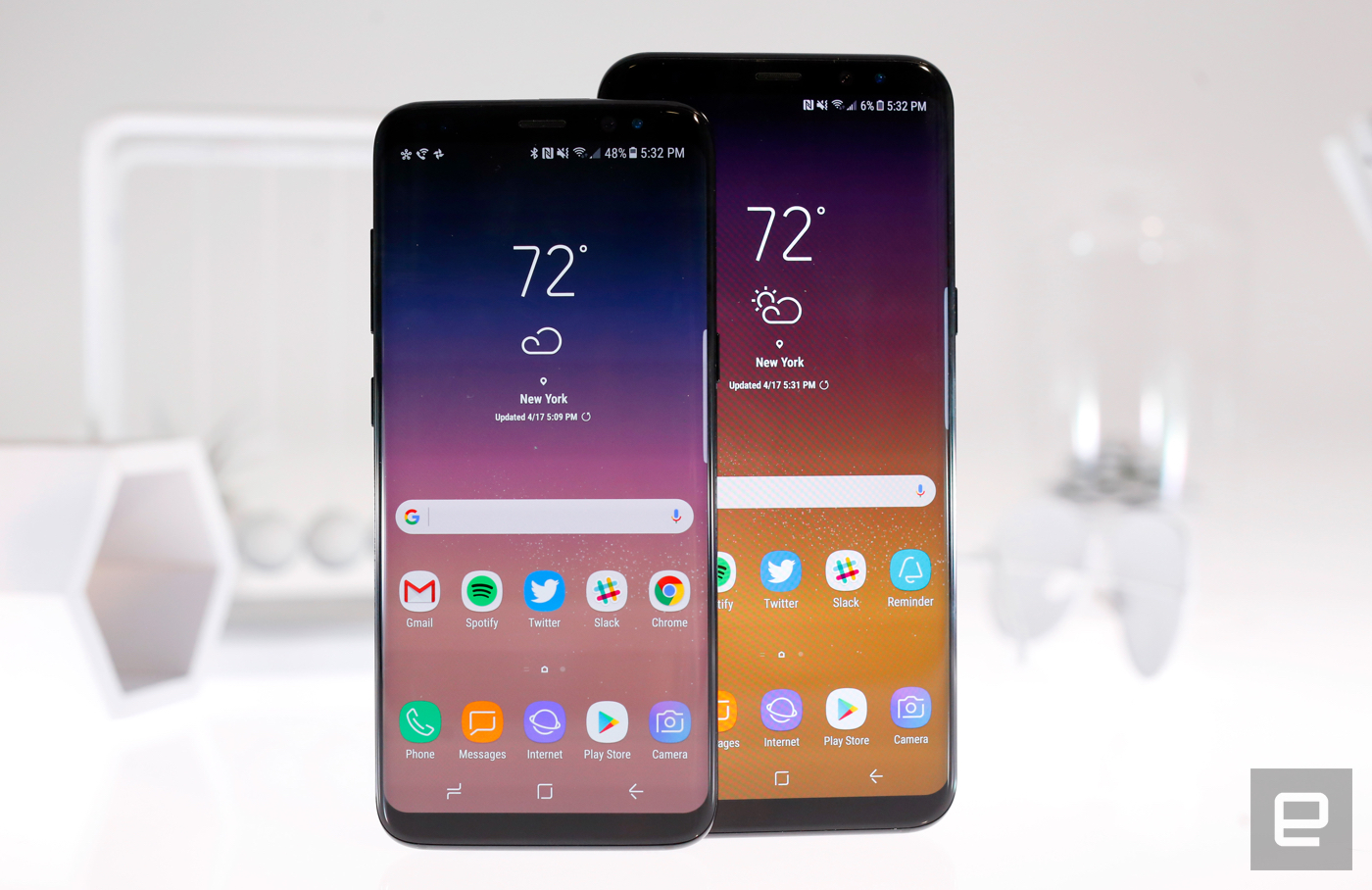
Text and photos don't do the S8 ($750) and S8 Plus ($850) justice. They're beautiful, if not exactly surprising. From their rounded edges to their precisely formed metal-and-glass bodies, they feel like smaller, sleeker versions of the Galaxy Note 7. That's a hell of a compliment, battery insanity notwithstanding — the Note 7 was a beautiful device and I'm glad that DNA lives on. The S8 and S8 Plus's rounded Infinity displays — which are 5.8 and 6.2 inches big, respectively — only add to the phones' appeal. We'll dig into these curved screens more later, but people seemed to like them enough that it didn't make sense to have non-curved flagships anymore.
The screens don't extend any farther down the phones' sides than the S7 Edge's display did, but the bezel surrounding them has almost completely disappeared. LG's G6 packs a similarly long 18:9 screen, but the S8 line's eye-catching curves and impressive precision give Samsung a distinct advantage. Like the G6, the screens on the S8 and S8 Plus are longer and narrower than usual, helping them fit more snugly in your hand.
This is especially true of the S8. I thought I'd prefer the Plus's large display, but there's something reassuring and alluring about this smaller body. For one, my hands never strained while reaching for the screen's far corners, and I never felt like I'd drop the S8 because my hand wrapped around it so well. (The phones' backs are made of glass, though, so they still slide around on tabletops.) That's not to say the S8 Plus feels too big. It's plenty comfortable to hold, although your thumbs will still get a workout reaching around the display.
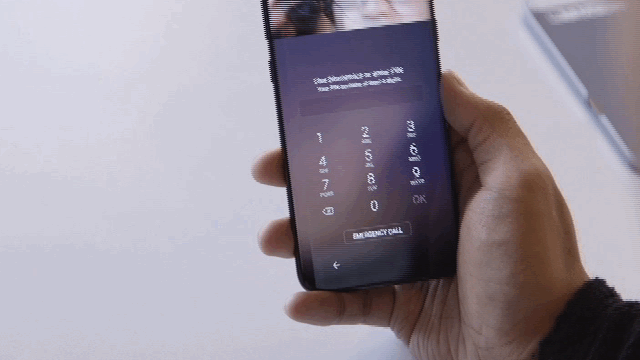
Above the screens are improved, 8-megapixel cameras, and a Note 7-style iris scanner for hands-free unlocking. Most of the time the scanner is fast and frictionless. Often it didn't even show the guide to align your eyes with. Other times I had to open my eyes really wide and move the phone around until I either nailed the alignment or got frustrated and just punched in my PIN.
If PIN codes aren't your thing, there's also the fingerprint sensor on S8 line's back, next to the camera. In prior models, it lived below the screen. I didn't mind the change conceptually, but the placement needs work. The sensor is off center, and a little too easy to miss — I usually smeared fingerprints all over the camera before finding it. And what of that classic home button? It's gone -- your new home button is a pressure-sensitive spot on the screen that vibrates when you push it.
If you're not paying attention, you'd easily miss one of the S8 line's biggest additions: a small button below the volume keys on the phones' left sides. This is what you'll use to invoke Bixby, Samsung's homebrew virtual assistant. The button doesn't do much yet — you'll eventually be able to long-press it to speak directly to Bixby, but for now, it just brings up a screen with upcoming appointments, news and such. Even worse, Samsung has blocked attempts to remap the Bixby key for other functions, which has only pissed off potential power users.
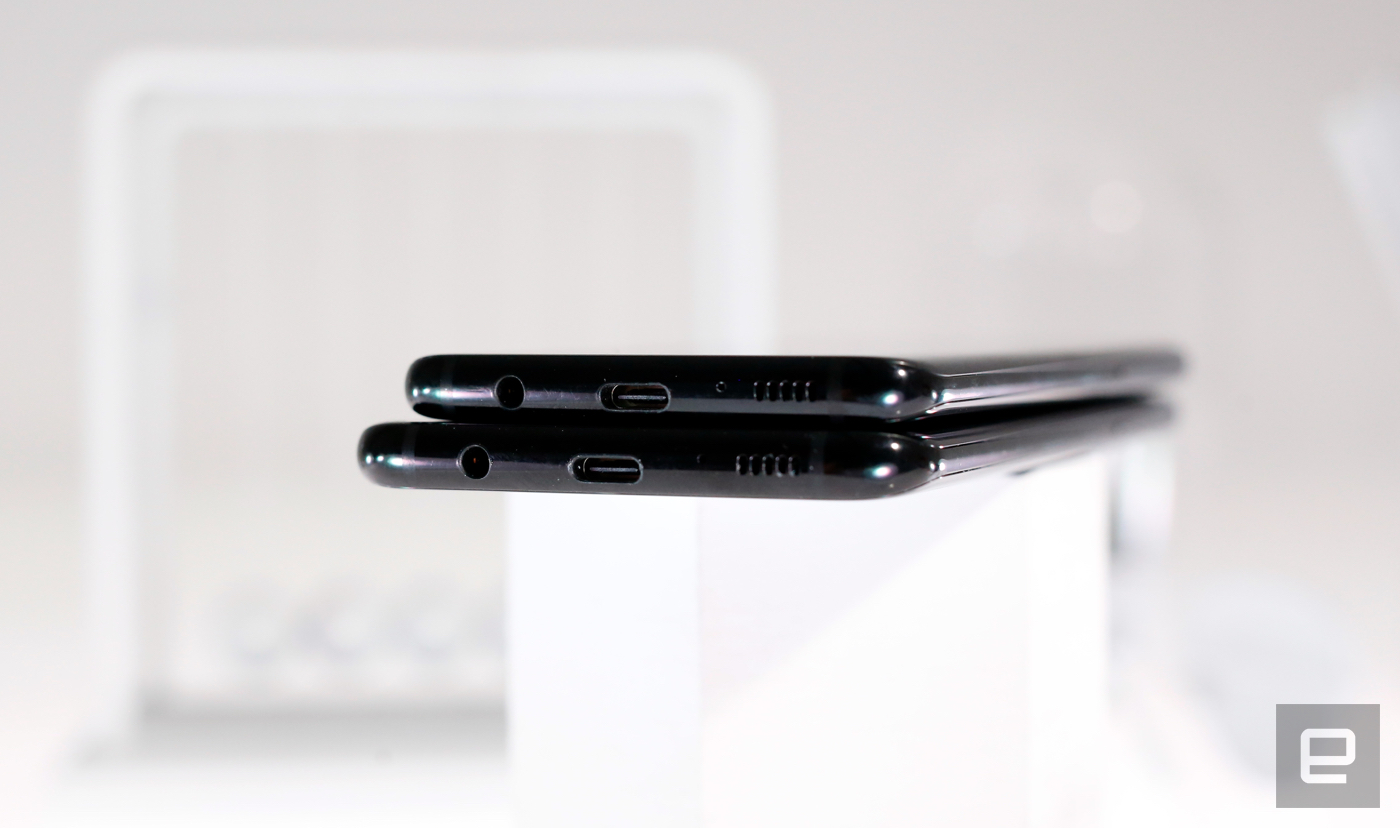
There's a USB-C port on the phones' bottoms, and next to that? The headphone jack. We've seen companies ditching this classic port, claiming that it took up too much space. The S8 and S8 Plus are perfect repudiations of that line of thinking. Oh, and they don't get in the way of waterproofing, either. Both devices are IP68 dust and water-resistant, which meant they could lounge for up to 30 minutes in the ridiculous wine bath we poured.
The stuff inside the S8 and S8 Plus isn't exactly a surprise. Both US models pack Qualcomm's new octa-core Snapdragon 835 chipsets, along with 4GB of LPDDR4 RAM and Adreno 540 GPUs. That horsepower is paired with 64GB of internal storage, and you can add up to 256GB of additional space with a microSD card. In addition to the usual array of LTE and Wi-Fi 802.11 a/b/g/n/ac radios, the S8 and S8 Plus also pack support for Bluetooth 5.0, an updated version of the standard that promises faster data speeds and longer range.
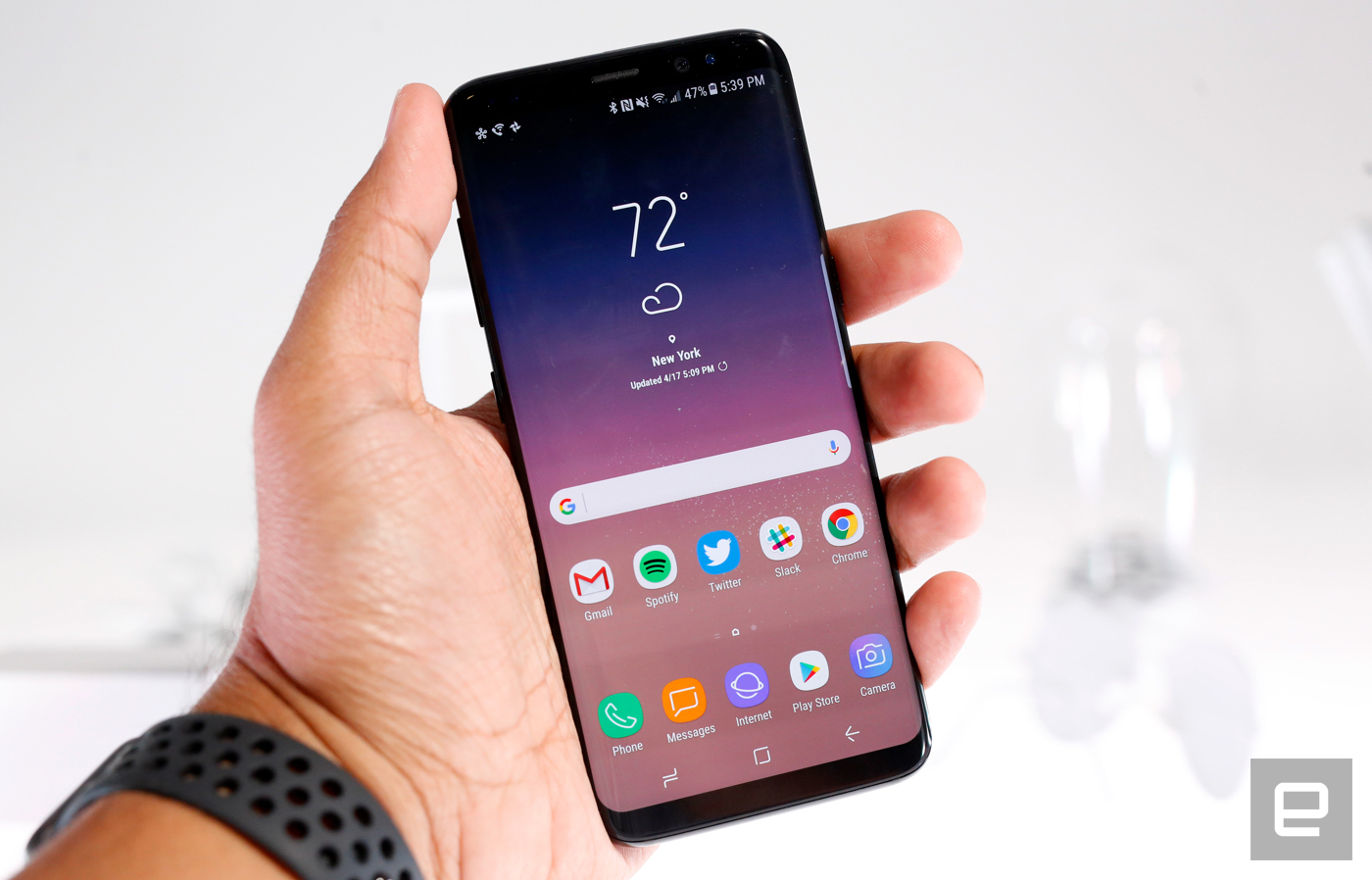
As always, the S8 and S8 Plus are more alike than they are different. The biggest difference aside from the screens are the devices' batteries — the S8 packs a 3,000mAh cell while the Plus contains a 3,500mAh battery. Those of you with keen memories will remember last year's smaller Galaxy S7 also packed a 3,000mAh battery, and the S7 Edge actually had a slightly larger 3,600mAh — the biggest Samsung had used to date. Given the Note 7's nightmarish battery failures, it's no surprise the company didn't push the envelope on this front.
Samsung did an impeccable job designing and assembling these phones. You'll find a few touches that don't feel quite right, like the off-center USB-C ports, but it's clear countless hours went into making the S8 and S8 Plus feel seamlessly elegant. Sorry Apple, HTC, and the rest: For now, Samsung is the reigning king of smartphone design.
Display and sound
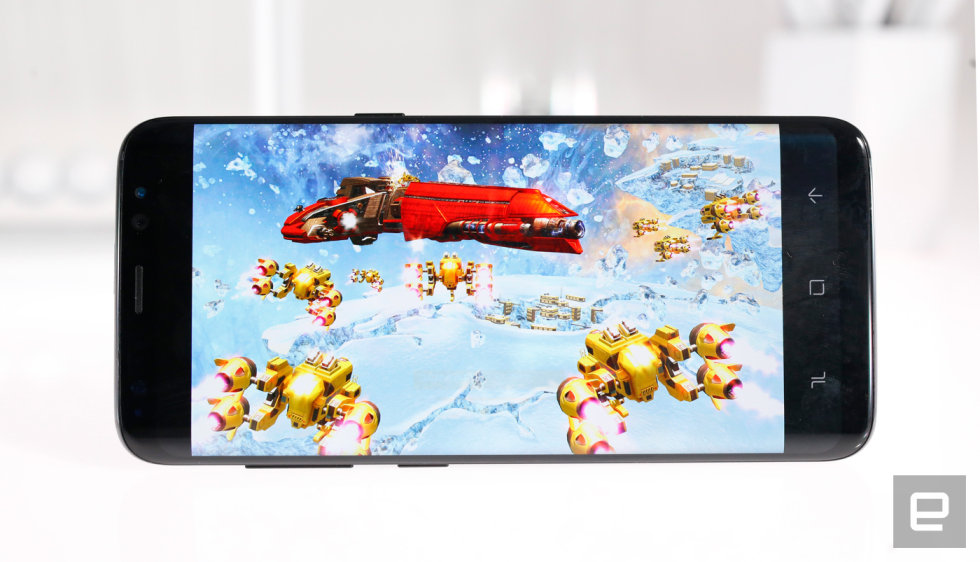 Chris Velazco/Engadget
Chris Velazco/EngadgetFor the people in search of buying advice, here's all you need to know about the S8 and S8 Plus's screens: They're awesome. Thanks for reading.
But seriously, the Super AMOLED panels here are indeed awesome. Color reproduction on both is excellent and, as always, there are different screen modes in case your tastes are more specific. The screens get bright enough to combat the warm spring sun and viewing angles are excellent, too.
Before anything else though, you'll notice that the S8 and S8 Plus screens are longer than most. While many other smartphone screens stick to the 16:9 widescreen aspect ratio, Samsung built the S8 screens with an 18.5:9 aspect ratio. Why? To squeeze more screen into your hand, for one. Beyond that, the length of the screen makes multi-window multitasking — like the kind Nougat natively supports — a breeze. Don't worry, though: Your apps will automatically scale to fit the entire screen, and they'll look damned good in the process. Some videos, meanwhile, will be flanked by black bars since they can't fill the screen. Samsung isn't the first to go this route, though. Rival LG had the same thought when building its G6, which uses an ever-so-slightly shorter 18:9 aspect ratio.
Samsung calls these screens "Infinity Displays," and they run at resolutions as high as 2960x1440 — a little longer than the usual Quad HD. Note that I said, "as high as." The phones are set to run at "Full HD+" — meaning 2220x1080 — by default. You'll need to jump into the devices' settings to coax them into running at full resolution, which is a must when you fire up some Gear VR games. There's also an option to dial down the screen's resolution to "HD+," or 1480x720, in case you need to squeeze as much life out of the battery as possible. The display will set itself to this resolution when you turn on the most aggressive power saving mode, and it's not too bad, either. Icon edges and text look slightly fuzzier, but it's not ugly.
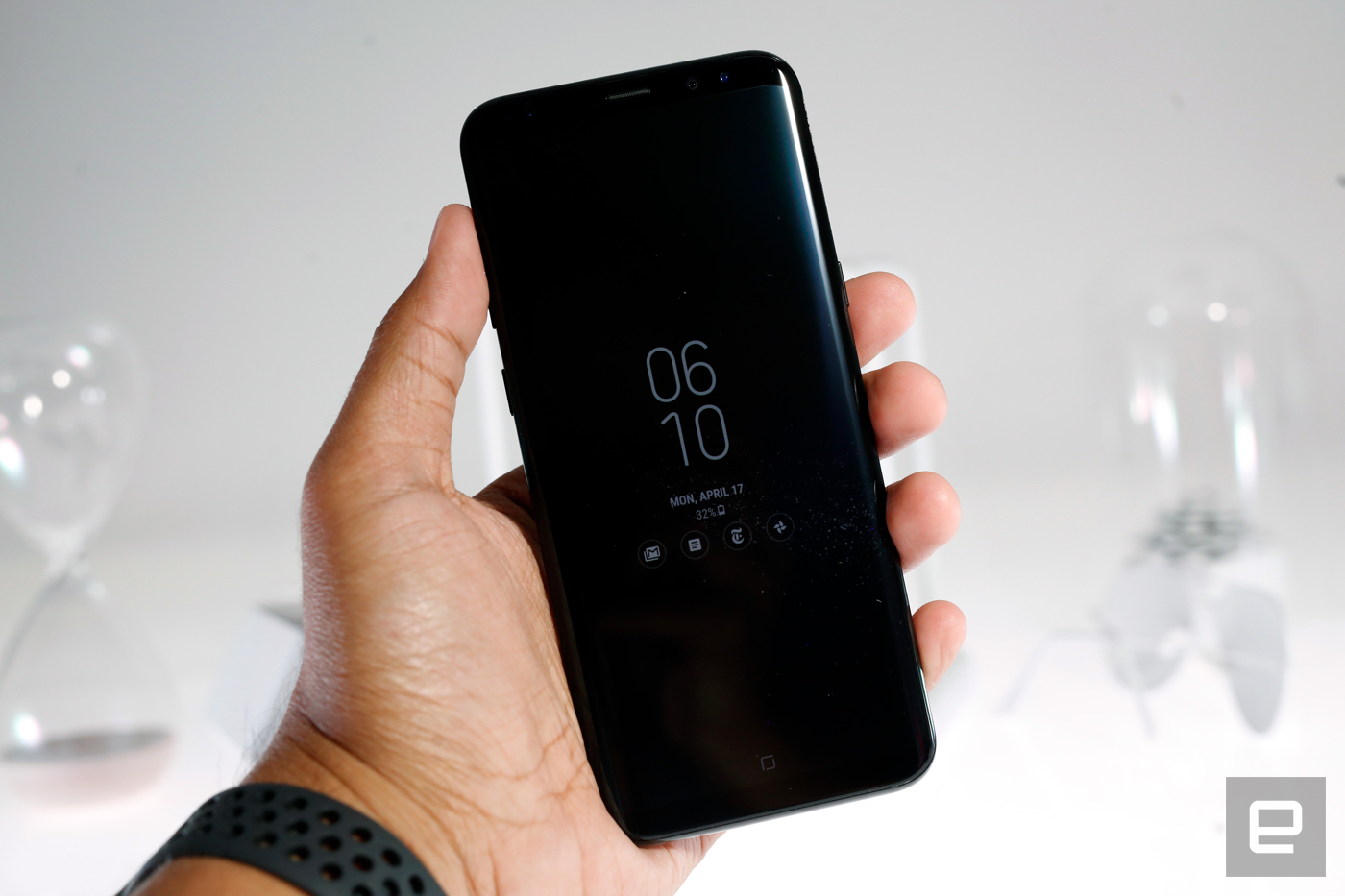
The always-on display is back too, but with a twist. You can customize it further with images in addition to the usual clocks and calendars. Always-on widgets are available now too, if you want to see your calendar appointments or media controls without unlocking the S8. The impact on battery life is negligible, and the sheer amount of customization options can help make your device feel, well, like yours.
Meanwhile, each device has one speaker wedged into its bottom edge, and they pump out loud -- if thin -- audio. They're good enough for podcasts and YouTube videos, but getting the most out of your tunes requires headphones. Good thing, then, that Samsung included a set of AKG earbuds with each S8, and they're leagues ahead of most chintzy pack-ins.
Software
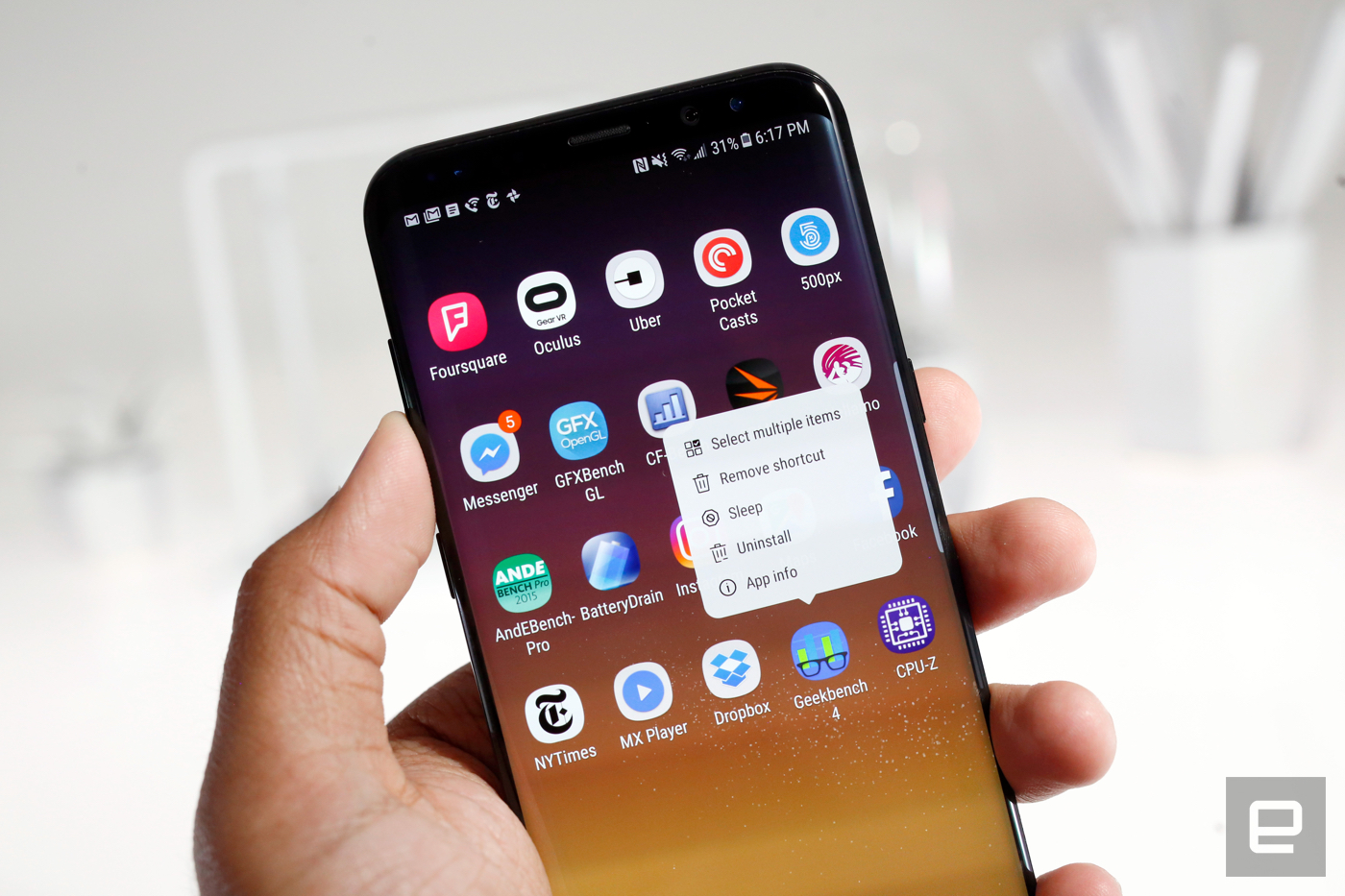
The Galaxy S8 and S8 Plus both ship with Android 7.0 Nougat, but you'd be hard-pressed to tell at a glance. Samsung has once again painted over Google's work. Though, TouchWiz has finally grown up. A lot. Look at the S7's interface: It's full of garish icons and brightly colored circles. The S8's, in contrast, is subtle and thoughtful in its design choices.
For one, the app launcher button is gone — now you just swipe up or down on a homescreen to see everything you've installed. Even better, there's a search bar at the top of the launcher. Managing apps is also easier. Long-pressing an app icon launches a pop-up window with options to add a shortcut to the homescreen, select multiple apps and uninstall or disable the ones you've selected. That last bit is crucial when you're dealing with carrier-mandated bloatware, like the multiple T-Mobile apps on our review unit. In days past, you had to disable uninstallable apps from the device's settings; now you can do it wherever your app icons live.
The virtual navigation keys also allow me to fix one of my biggest pet peeves. Samsung devices typically have their recent apps key on the left side and the back key on the right — basically every other Android phone has it the other way around. Fortunately, you can swap the order they appear. You can also now swipe down on the rear-mounted fingerprint sensor to open the notifications shade, a neat trick we first saw on Google's Pixels.
Other flourishes make the S8 line feel like "greatest hits" devices. Since both phones have curved displays, they inherited the Edge line's special shortcut panels. Tapping the little tab on the right side of the screen reveals panels you can load up with favorite apps and contacts and more. I use these as often as I did on the S7 Edge — which is to say rarely.. One panel, called Smart Select, is an awfully neat Note 7 throwback. Long story short, you can select and record parts of the screen and doodle all over them to create GIFs on the fly. For better or worse, /I can't stop doing this./

Also returning from the Note 7 is a Game Launcher app and the device optimizer in settings, which lets you quickly close down background apps and delete unneeded files. My personal favorite feature is the Secure Folder, which allows you to hide files and install separate instances of apps away from the rest of your stuff. For example: Photos taken from the camera app within the Secure Folder can only be viewed when you've successfully unlocked the folder.
Just remember that not all security features are created equal. Take Samsung's facial recognition -- it's fast, but it often couldn't identify me in poorly lit situations. It's also technically possible to fool this facial lock with a convincing photo, so exercise caution. Samsung concedes that this is one of the less secure ways to lock down your phone, but some people definitely dig convenience over security.
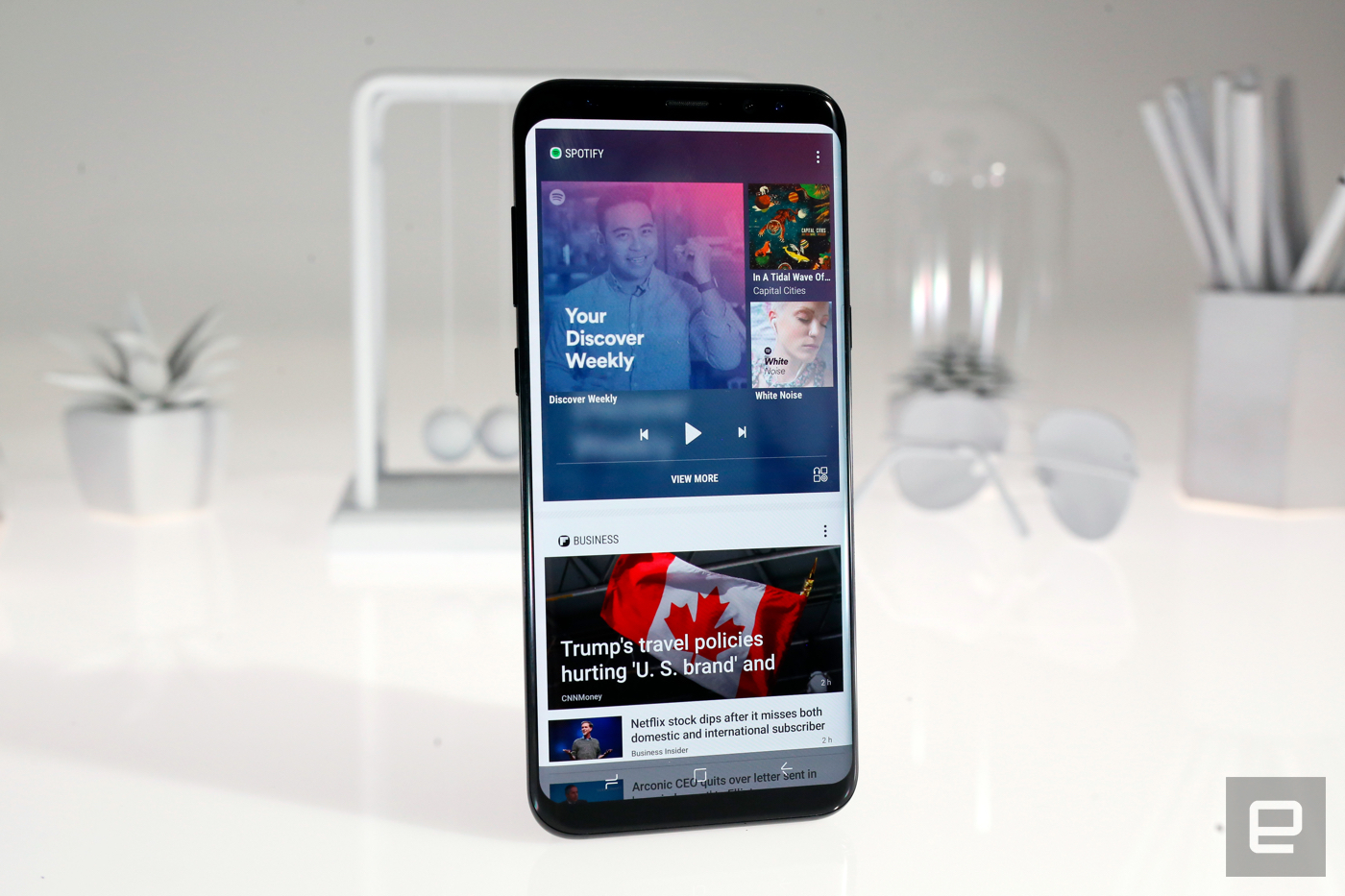
Camera
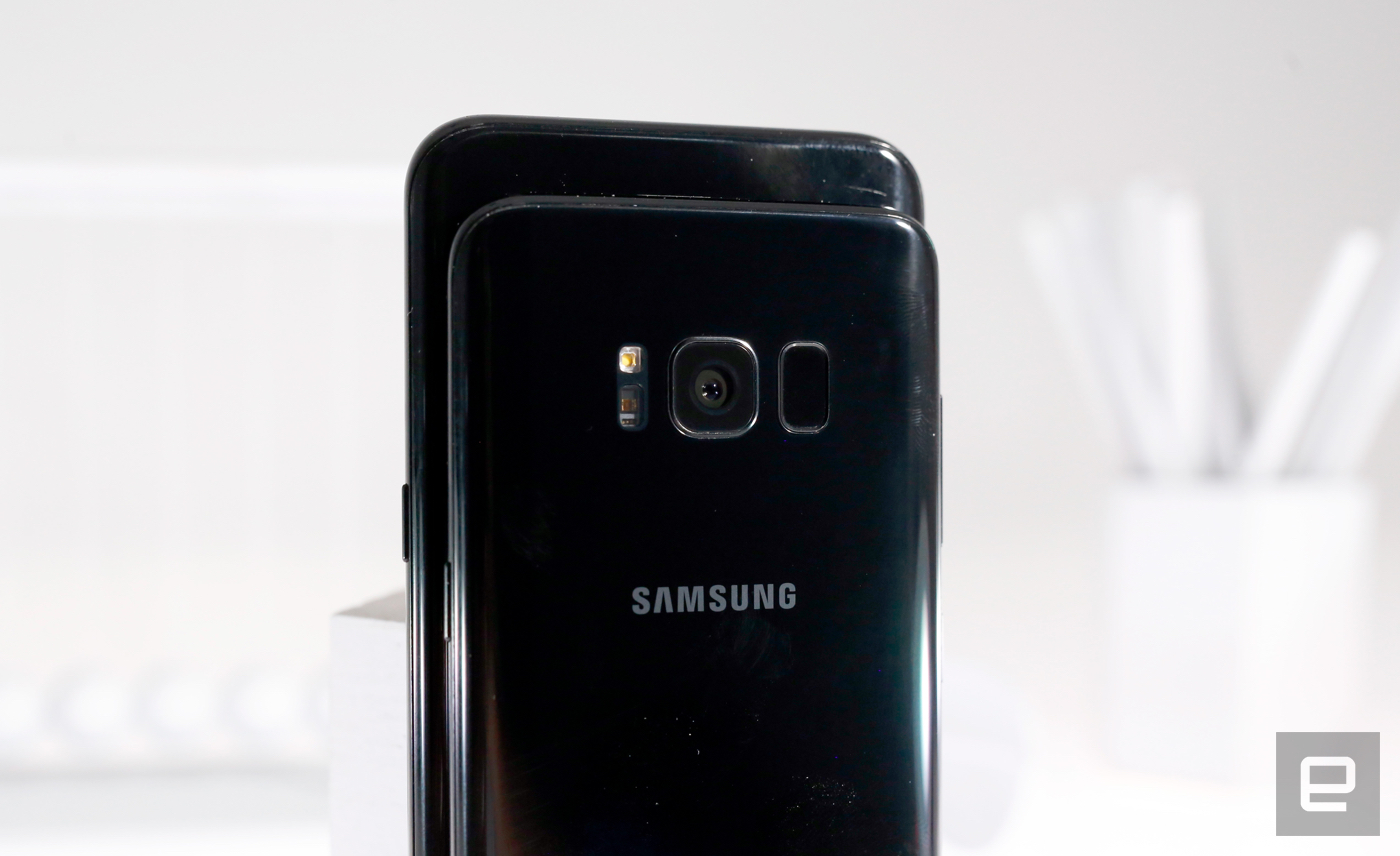
The 12-megapixel sensors on the back haven't changed much since last year. That's not a bad thing since they were great cameras to start with; just don't expect any huge jumps in quality. Photos were uniformly well-exposed with excellent color reproduction. And as always, these dual-pixel cameras focus incredibly fast, and the optical image stabilization does an excellent job keeping subjects crisp and clear. Low-light performance was in line with the S7 cameras, which is no surprise since they both have 1.4µm sensor pixels and f/1.7 apertures. Still, expect to see the occasional fuzzy edge and less-accurate focusing when it gets a little too dark. Samsung says it improved the processing pipeline so there's no lag between capturing a shot and being ready to snap the next.
The S8 and S8 Plus also double as solid video cameras. They capture quality footage at up to 4K with great colors and minimal jittering. I just wish Samsung offered more flexibility — there's a record button, and that's about it.
There is an improved 8-megapixel front camera with a wider field of view for group selfies. It has a f/1.7 aperture too, so it's decent enough in low light and in general it's a great performer. Selfies were clean, detailed and nicely colored, especially when viewed on the punchy AMOLED screen. Even better, you can hold up a palm to snap a selfie, no fumbling with buttons required.
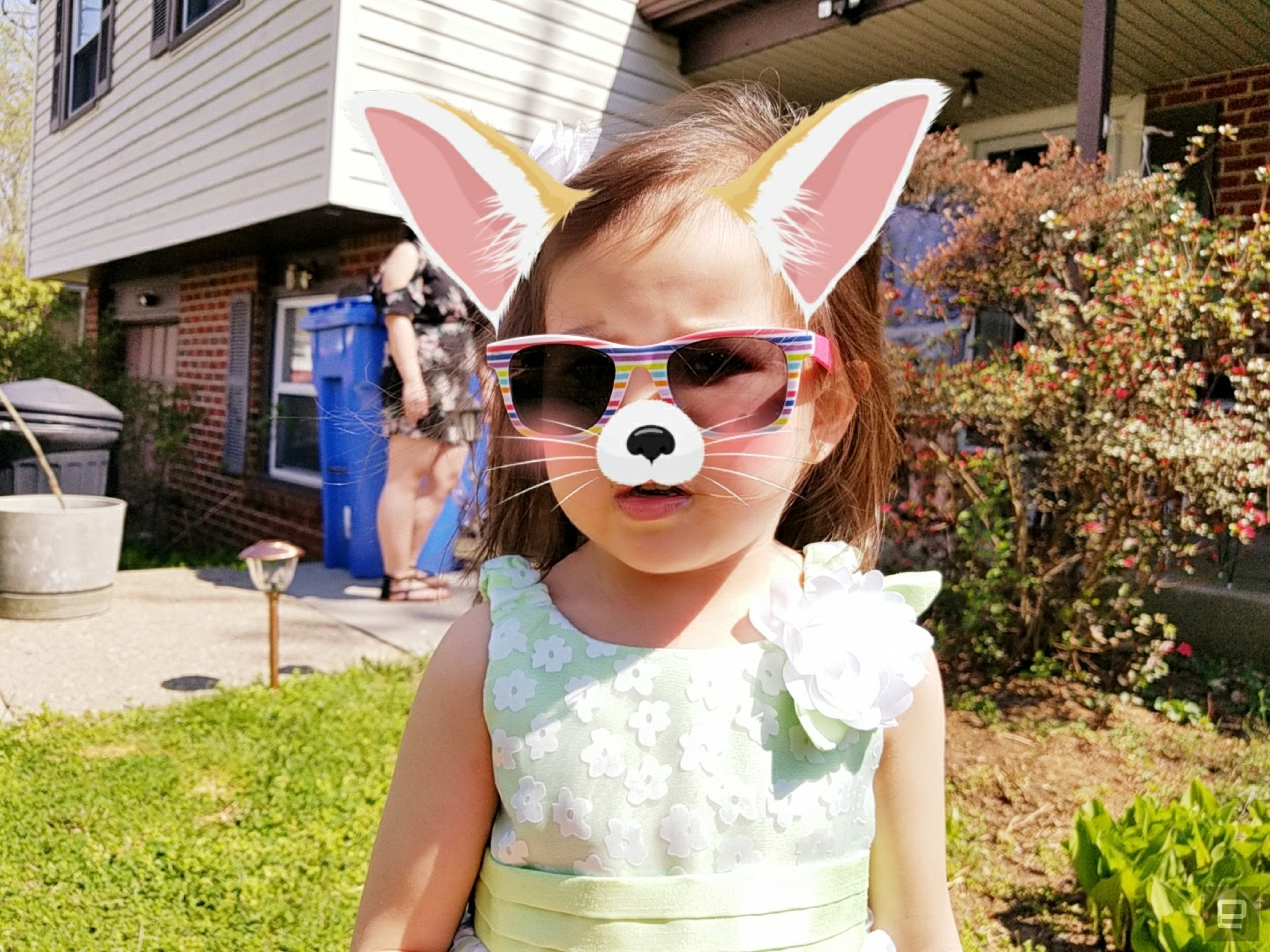
Samsung also spent time cleaning up the camera interface, which was already pretty elegant. You switch between the front and rear cameras with a swipe up or down, and the list of usual photo modes — food, selective focus, slow motion and "pro" — is smaller and more streamlined. This time, though, swiping right opens up a list of Instagram-friendly color options to give your photos a little more character. And speaking of character, Samsung took a page from Snapchat's playbook and added face-tracking filters that are bizarre and fascinating. They range from the cutesy (kawaii cats and rabbits eating carrots) to stranger fare, like a cowboy filter that fires a pistol when you blink. The S8 and S8 Plus come with 31 of these filters, and if nothing else, they're perfect for amusing toddlers who are otherwise busy getting loaded on Easter candy.
Performance and battery life
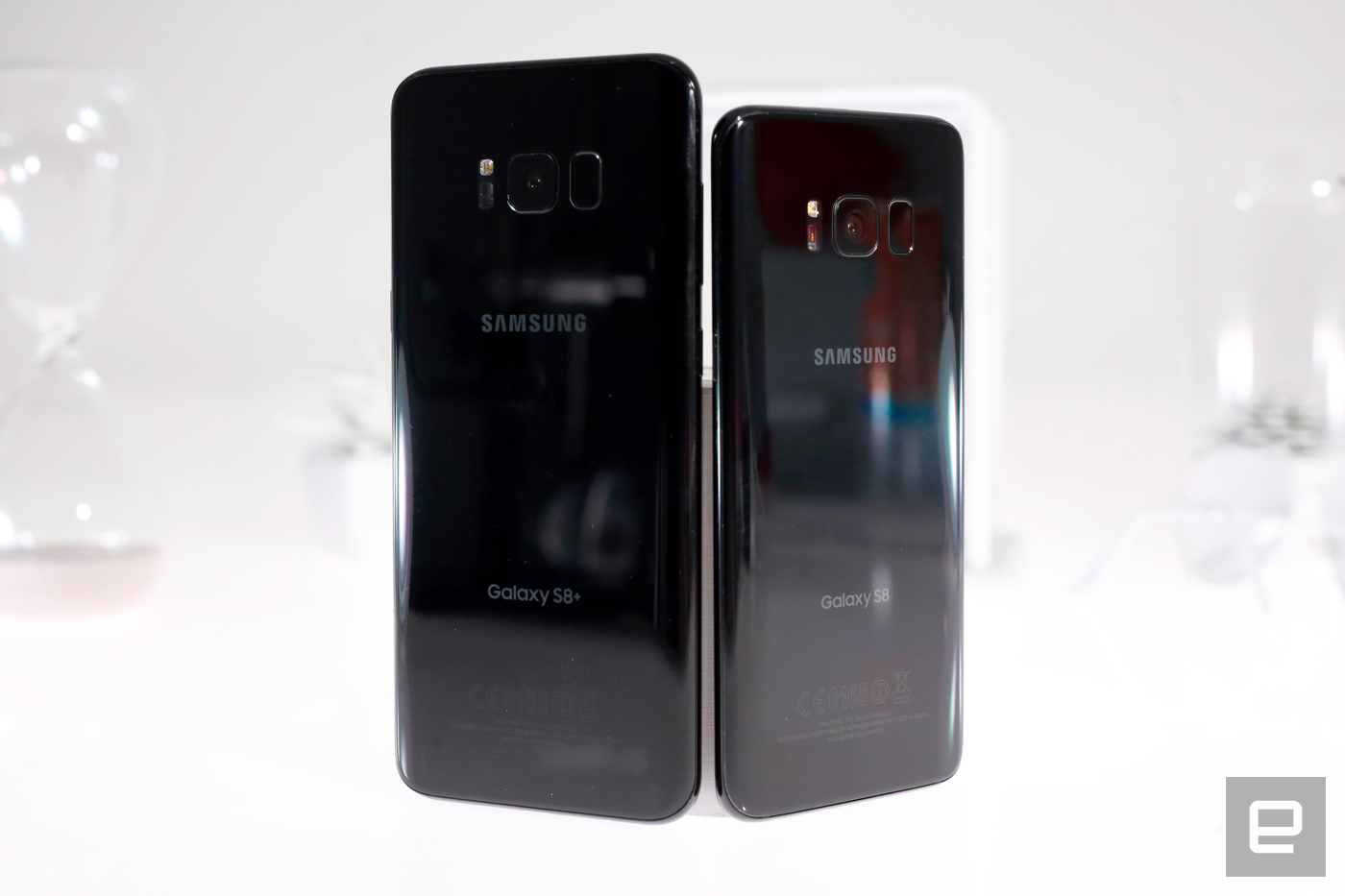
I'll be brief: The S8 and S8 Plus are effortlessly fast machines, and hardly anything I threw at them over a week of testing got them to stutter. This is mostly due to the shiny new Snapdragon 835 and 4GB of RAM onboard. Bixby is often a little slow to launch, but swiping through Samsung's improved interface and jumping between running apps was painless. If this is what the 835 is capable of, I can't wait until these things are everywhere. Workday multitasking, games like Hearthstone and Dead Trigger 2, even playing emulated GameCube games — it all ran fabulously. I unconsciously stopped thinking about performance altogether. As you'd expect, the S8s killed it in our usual suite of benchmarks, too — hardly anything came close.
iPhone 7 and 7 Plus
You don't need me to tell you that this year's iPhones look an awful lot like last year's. Like it or not, Apple believed there was still room to improve the phone design we've been using for two years, so it focused on that instead of cooking up a brand-new aesthetic. It's tempting to say Apple's current design philosophy boils down to "if it ain't broke, don't fix it," but that's not really true either: The company actually fixed a lot this year.
Some changes are subtler than others. The 7 and 7 Plus's antenna bands swoop around the phones' curves instead of cutting across their backs. The iPhone's 12-megapixel camera (or cameras, in the case of the 7 Plus) is surrounded by an aluminum hump, rather than just jutting out like in the old days. Apple finally made 32GB the new storage baseline and gave the 7 and 7 Plus a seriously spacious 256GB option. Both models are the exact same size as the models that preceded them, but the 7 and 7 Plus have each shed a couple of grams here and there. The loss of a few paper clips' worth of weight isn't nothing, though, especially when we're talking about devices that we hardly ever put down.
From there, the list of changes starts to look more substantial. If you're lucky, you'll never need to know that the 7 and 7 Plus meet IP67 water-resistance standards. In other words, they're built to withstand dust ingress and, more important, submersion in up to a meter of water for 30 minutes. Apple's rivals have made big strides in making their smartphones more life-proof, so all I can really say is: It's. About. Time. Finally, we get iPhones that'll survive when you drop them in puddles, get caught in the rain or intentionally dunk them in beer. (Note: liquid damage still isn't covered by Apple's warranty.) Catching up to the competition has never been so welcome, or so tasty.

Meanwhile, the all-too-familiar home button isn't a physical button anymore. It's a solid-state affair that makes the phone taptically throb when you push it. This wound up being way more divisive a tweak than I expected; when I showed it off to colleagues, just about all of them recoiled at first press. As a longtime iPhone user, I can't quite explain how off the sensation felt at first, but it only took about a day for me to get over it. Now it's a little weird to press an older iPhone's home button and not get the little bzzt of feedback from the Taptic Engine; but I digress.
The phones come in new colors too: a matte black and "jet black." The former looks exactly what you'd expect a black iPhone to look like, though the dark finish does a good job obscuring those antenna bands. Jet black, meanwhile, is at once lovely and a bit of a bummer. When I say lovely, I really mean it: The moment I touched one, I couldn't believe it was made of the same 7000 series aluminum as the others. In fact, it doesn't feel like metal at all, thanks to Apple's lengthy anodization and polishing process. Jet black iPhone bodies feel just as glossy and slick to the touch as their glass screens, and that unity makes them feel like seamless, cohesive wholes. The entire thing is seriously impressive, even if it feels sort of plasticky.
Then the scratches and smudges appear. I'm not a case person, but I take good care of my things and exercised what felt like a more than reasonable level of caution carrying these new phones around. It didn't even take 24 hours for the first batch of scratches to appear on my jet black iPhone 7's back, which was either the result of placing it on a bar's granite countertop or repeatedly shoving it into my empty jeans pocket. Those little nicks have only multiplied, which could be an understandable deal-breaker for some of you.
And now we've come to the elephant in the room. Neither the iPhone 7 nor the iPhone 7 Plus has a traditional 3.5mm headphone jack. To hear Apple tell the tale, getting rid of that decades-old standard wasn't just a practical move to make waterproofing and increased battery life possible -- it was also an act of "courage." Here's a bit of unsolicited advice for Apple: I get that changing the world is sort of your thing, but maybe go easy on the hubris next time. Anyway. I'll dig into audio quality in just a moment, but suffice to say that the toughest part of not having a headphone jack is trying to break all my old listening habits. I can't tell you the number of times I tried to plug a regular pair of earbuds into these phones before -- d'oh! -- remembering that doesn't work and then having to root around for the included Lightning-to-3.5mm adapter.
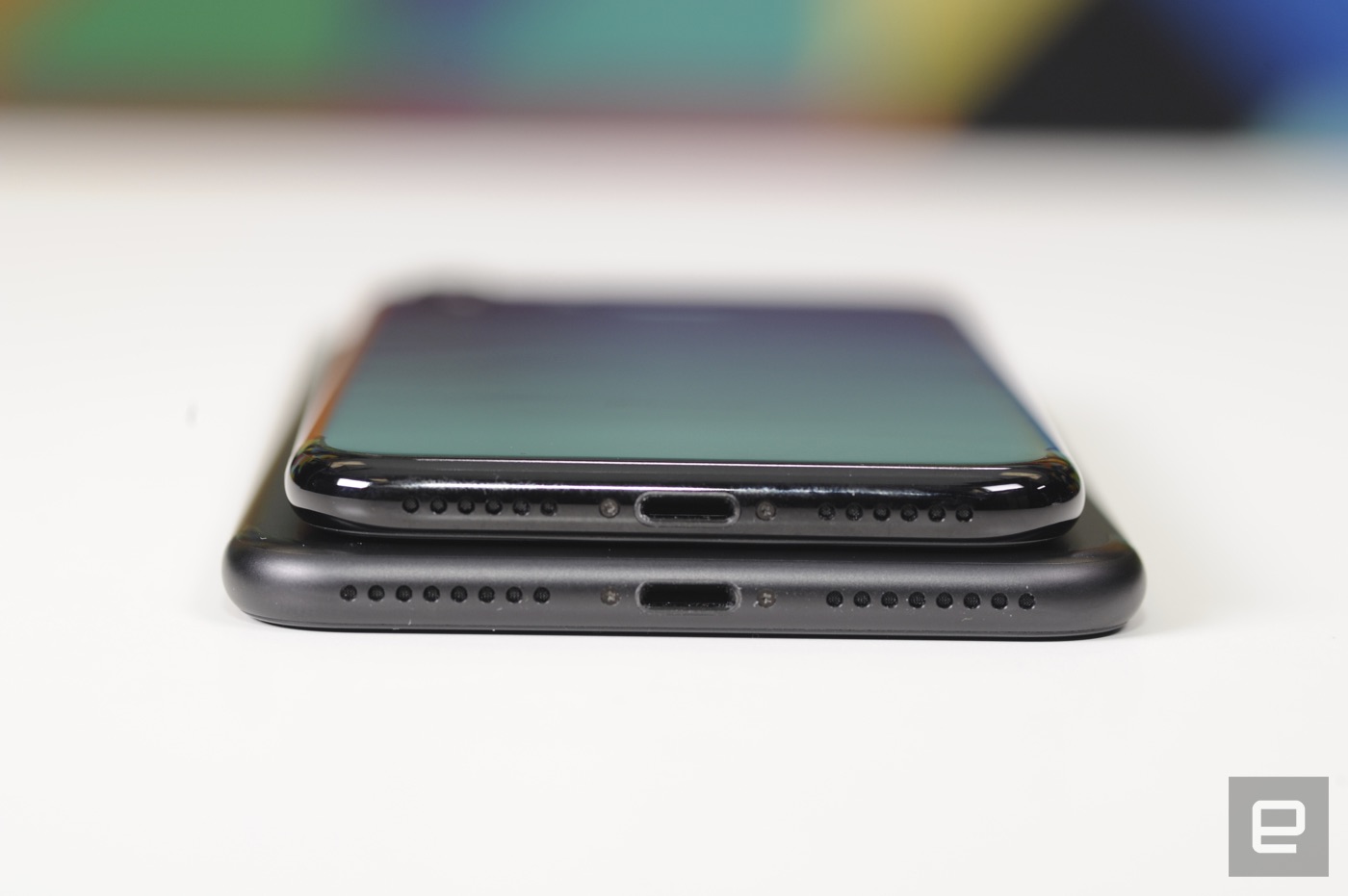
This also means you can forget about charging your phone while listening to music at the same time -- unless you have wireless headphones or are willing to buy a third-party adapter to split that Lightning port. (When asked if the company planned to release its own splitter, an Apple spokesperson said they had "nothing to announce.") The iPhone 7 and 7 Plus have better batteries than the models that came before them, so charging and listening honestly hasn't been a big issue, but still, no one would fault you for crying foul. Either way, Apple isn't the only company to have signed the headphone jack's death warrant. Motorola released two flagship phones this year that used their USB Type-C ports for audio, though it did so at least partially because it expected Apple to ditch that jack, too.
Display and sound
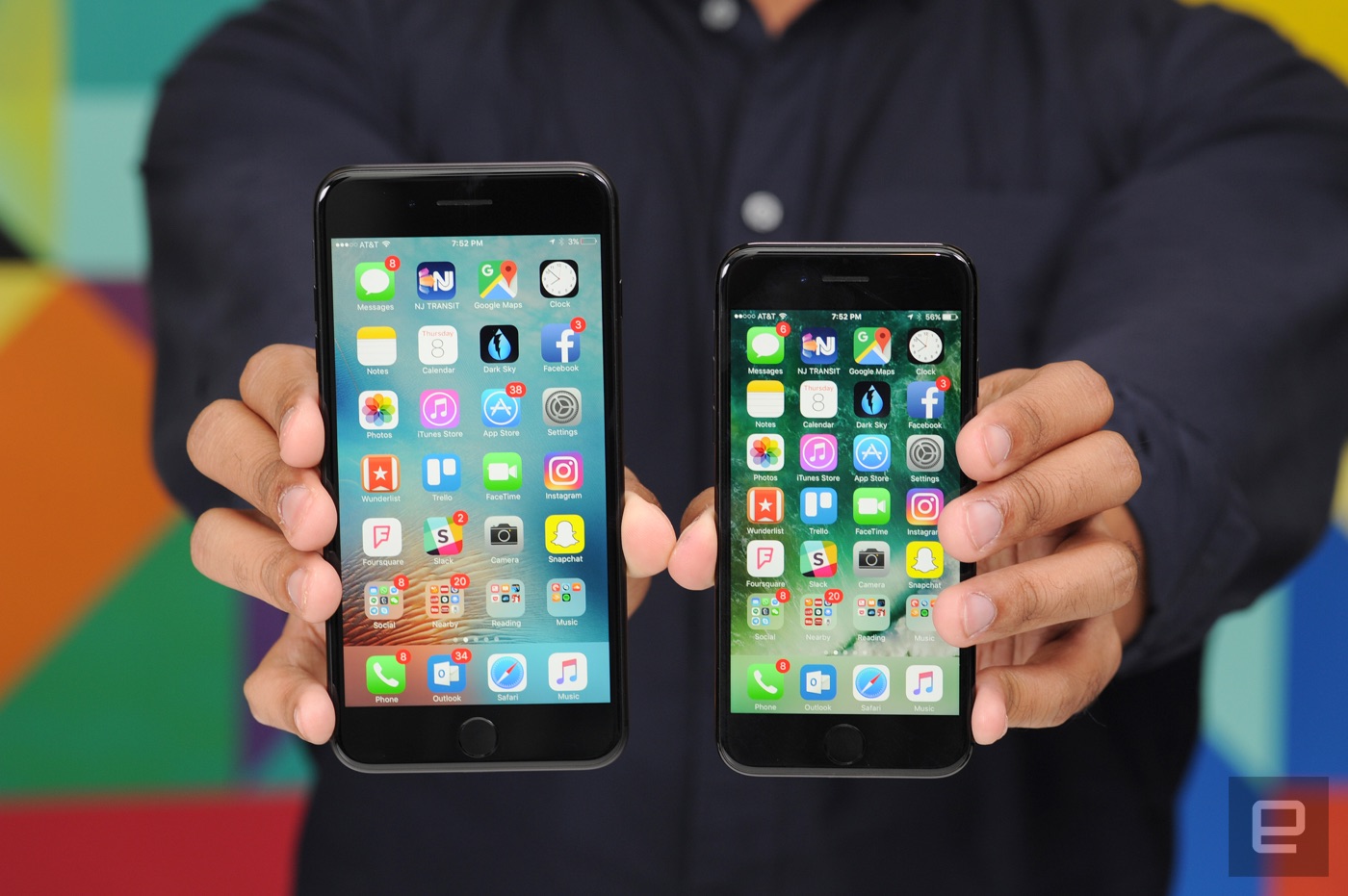
Once again, the smaller iPhone 7 has a 4.7-inch Retina HD screen, while the Plus has a 5.5-inch display. The resolution and pixel density are the same too, so you're not going to be seeing anything more crisply now than you did in 2015. Rather than chase other companies squeezing higher-res displays into their phones, Apple chose to focus on a more fundamental part of these screens: how they render color. The 7 and 7 Plus support the DCI-P3 wide color gamut, which -- long story short -- means they're capable of reproducing more colors than the standard sRGB color range. Put another way, they're able to display more vivid, nuanced images than the iPhones that came before them, thanks to a color space that's standard in the film industry.
So what does that mean for your day-to-day life? Well, it kind of depends on how good your eyes are. The difference between these displays and the ones we got last year aren't always obvious. Colors are often a touch brighter, and you can see subtle shades that help images feel more lifelike: Skies are bluer, sunsets are warmer and people's skin looks more lively. Then again, changes that seemed subtle to me were more pronounced to others, so maybe my eyes are a little dim.

The screens in the iPhone 7 and 7 Plus are also notably brighter than on last year's models, and they've gained a new trick for when you're outdoors. Apple says it uses the 7 and 7 Plus's ambient light sensor to tell if you're inside; if not, the screen can get even brighter to compensate for sunlight. That's right: Not all maximum brightness levels are created equal. That being the case, I'm a little surprised Apple didn't bring the 9.7-inch iPad Pro's TrueTone color-temperature-tweaking system to the 7 and 7 Plus. My guess is they couldn't squeeze it into these phones' smaller bodies.
Here's another first: The 7 and 7 Plus are the first iPhones to feature stereo audio (another trick Android phone makers have dabbled with for ages). Why it took so long for Apple to try this eludes me; they're a huge addition to the iPhone formula. Movies, podcasts and speakerphone calls sound dramatically better now, though the stereo separation doesn't seem quite as pronounced as on devices like the old HTC Ones. That's thanks to Apple's speaker setup -- rather than stick two speakers right on these iPhones' faces, sound springs forth from the main earpiece and the speaker on the bottom-right edge. I'll take it.
If you're still bristling about the whole needing-an-adapter-for-your-headphones thing, well, at least the sound quality doesn't suffer in the process. I used my go-to headphones (a pair of Samsung Level On PROs) to listen to the same music on the 6s and on an iPhone 7 with the Lightning adapter, and couldn't tell any difference at all. Ditto for a blind listen-off between the 6s and the 7 Plus: They sounded identical to me.
Camera
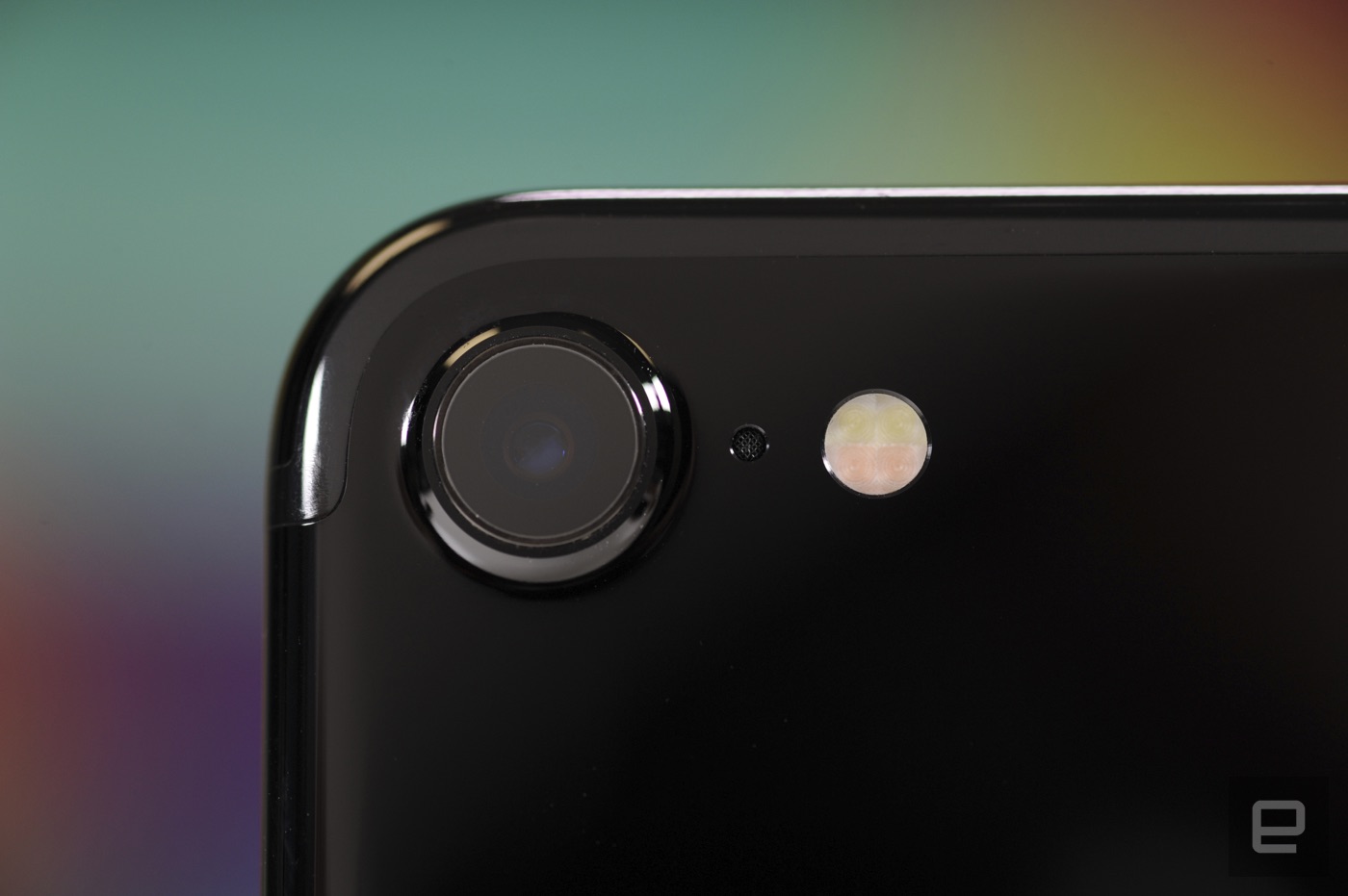
This is where things get really interesting. By now you know the iPhone 7 has a single 12-megapixel camera on its back, and guess what -- it's a damned good one. That's saying something, considering there's been no resolution boost since last year, and the pixels on that new sensor haven't gotten bigger either. And yet the photos they capture come out significantly better; there wasn't a big difference in how much detail was captured, but colors looked more vibrant and true to life than on the iPhone 6s Plus.
Surprised? You shouldn't be. The iPhone 7's camera captures more color data than previous ones (the better to view on that wide-color-gamut display), and the results are pretty great. In fact, I generally preferred shots taken with the iPhone 7 and 7 Plus to ones captured with a Galaxy S7 Edge. The latter captured a wider field of view and was sometimes better accurately rendering green landscapes, but the iPhone's leg up on colors meant their photos tended to look nicer (to me, anyway). Test shots taken with the iPhone 7 were also generally better exposed than similar shots taken with the 6s, which in my case usually meant fewer blown-out skies washing out my photos. But every smartphone camera does well when it's bright outside. What about when things get dim?
It's a toss-up. The inclusion of optical image stabilization across both versions of the iPhone 7 helps, as does the main camera's f/1.8 aperture. Props to Samsung: Photos taken with the S7 Edge did indeed look brighter, but the iPhone 7 and 7 Plus offered more natural colors. Before today I would've said the S7s and the Note 7s had the best all-around smartphone cameras, but now Apple is right there, neck and neck with the best of them. The iPhone 7's front-facing camera has also received a major upgrade. It's been bumped up to seven megapixels and inherited some of the architecture that made the rear cameras so formidable. Long story short, your selfies are going to look lovely. Oh, and videos look really nice too, since they exhibit the same accurate colors as stills. Go forth and vlog, you pioneer.

Then, of course, there's the iPhone 7 Plus's dual camera setup, which pairs a 12-megapixel wide-angle shooter with a 12-megapixel telephoto camera to give the Plus an actual zoom. Apple isn't the first to dabble in dual cameras, nor is it the first company to attempt this zooming configuration; LG tried it earlier this year with half-decent results. Apple's approach feels more elegant, though -- with a quick tap you can switch between 1x and 2x zoom modes, or you can drag a slider or pinch with two fingers for more precise control. By the way, you'll probably want to stay at 1x or 2x zoom (or somewhere in between). Apple added digital zoom up to 10x, and the closer you get to that ceiling, the noisier and more indistinct things get. That's not surprising, though.

This whole thing might sound like a gimmick, and it sort of feels like one for a few minutes. After that, the "what do I do with this?" factor falls away and the optical zoom just becomes a handy trick to have at your disposal. The photos turned out great too, though you might notice some differences in the colors and exposure if you take comparison shots with both of the iPhone 7 Plus's cameras. The secondary telephoto camera still shoots 12-megapixel photos, but it has a slightly wider f/2.8 aperture. Basically, it doesn't let as much light in, so the photos come out a little different. Avid photographers might take issue with these minute changes; everyone else need not worry. For now, this is the only trick the 7 Plus has that the smaller 7 doesn't, but that'll change soon. Apple's going to update it with a feature that lets you play with depth of field when you're shooting portraits, so you can get a little more bokeh going on.
Software
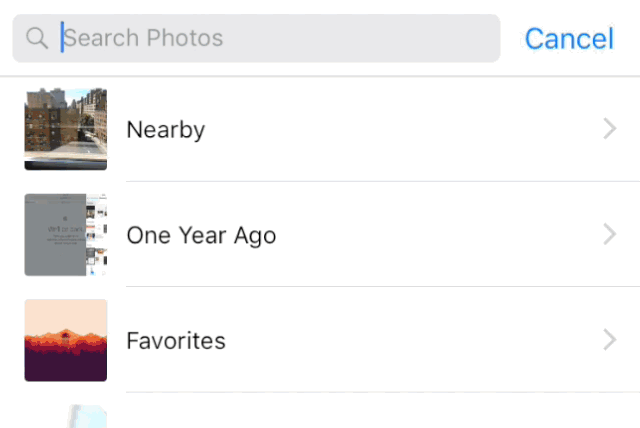
The iPhone 7 and 7 Plus might not seem like the most exciting hardware updates, but there's plenty to get excited about in iOS 10. Granted, very little of it will come as a surprise, since it's been available as a public beta for months now. Our full review is coming soon, and I've already detailed some of the new features, so I'll just recap the highlights here.
It took a while for me to get used to the revamped Photos app, but I sort of love it now. The app's original form was really basic: You could sift through your photos by "Moment" and poke around in albums, shared or otherwise. The iOS 10 version, meanwhile, uses machine learning to sort photos into themed "memories" based on where you've been and when you've done things. The best part: searching through all your photos by keyword, since iOS 10 uses AI to identify what's in your picture. As it turns out, I have 14 pictures with bibs in them despite not being a parent.

Apple's bright, bold new Music app was easier to jump right into, and I'm a fan now. The first time you launch the app, you're dropped right inside your music library (which is how it should be). All of the touch targets are bigger and easier to hit, even when I was glancing down at them mid-run. It's also satisfying to see 3D Touch finally get more use. I wrote in my iPhone 6s review that using that pressure-sensitive screen was something I eventually wanted to do all the time; too bad iOS 9's never tapped into its full potential. Not anymore. It feels like 3D Touch is connected more strongly to iOS 10's core; I've been using it to expand notifications, bring up contextual menus in Apple Music and glance at widgets for first-party apps like the dialer and Weather.
Apple is also making better use of the Taptic Engine this time around, so you'll feel it all over the place -- literally. The prominent examples are the ones you'd expect, like 3D-Touching notifications and using the home button, but you'll also feel a brief thud when you flick the Control Center open. Skimming your Apple Music collection for a specific song? Sliding your finger down the alphabet on the side of the screen feels like running your finger down a washboard, allowing you to more easily stop on a letter.
Oh, by the way, the process of forcing your 7 or 7 Plus to restart is totally different. Instead of holding down the power and home buttons like we have been for a decade, the new process requires you to hold down the power and volume down keys.
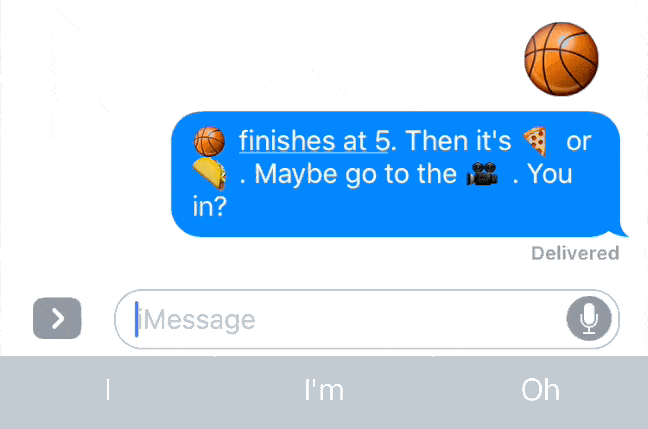
And now for some bad news: I still haven't been able to test some of iOS 10's headline features. Siri's intelligence is poised to get a big upgrade thanks to third-party apps, but I couldn't yet ask her to call me an Uber or send my friend $20 via Venmo. And while I'm also a little obsessed with sending these weird new iMessages, it's too bad that at time of writing, the iMessage app store was still virtually barren. I'll update this review as the store comes online and I get to play with more weird stuff.
Performance and battery life

Another year, another high-powered A-series chip to play with. The iPhone 7 and 7 Plus both run the company's new A10 Fusion, a quad-core chipset that pairs two speedy CPU cores with two longer-lasting ones that use 20 percent of the power the others do. It's easily the fastest chip Apple has ever stuck in a mobile device, beating out even the 9.7-inch iPad Pro's A9X processor. More important, there's basically zero difference in performance between the 7 and 7 Plus, even though the smaller version has 2GB of RAM, versus 3GB on the Plus.
Is bigger better? When it comes to the screens on our smartphones, yes. But when it comes to the body of the phone, not so much. That’s the reason we don’t all carry around a tablet every day. It’s also why so-called phablets often split opinion. The LG G6 laughs in the face of such concerns. It’s the phablet’s worst nightmare, because it puts a massive screen inside a truly compact body, redefining the genre and daring big-screen haters to get over their prejudices.
It’s also the follow-up to the LG G5, a phone that similarly attempted to redefine smartphones with its modular construction (but didn’t manage to do so). The G6 isn’t as bold or as risky as the G5, so has LG played it too safe this time? We’ve been using the phone for a week or so, and have plenty to say about it.
MAKING THE PHABLET MANAGEABLE
Many people struggle to believe the G6 has a 5.7-inch screen, because it feels so small in your hand. It’s easy to stretch your thumb across to the other side of the phone when holding it in one hand, and it remains usable at all times. Try that with any phone with a 5.5-inch screen, and it’s a struggle.
How has LG achieved this feat? It minimized the size of the bezels and chose an 18:9 aspect ratio, making it longer and thinner than the 16:9 aspect ratio screens found on most other phones. It’s the same aspect ratio as Samsung’s Galaxy S8.
The front of the G6 looks very modern, thanks to the rounded corners of the screen. It’s the screen that’s rounded, too, rather than a bezel over the top to give it the look. Combined with the rounded corners of the phone, it helps absorb impacts and lessens the likelihood of catastrophic screen damage. The thin top and bottom bezels make the screen stand out even more, and enhance the minimalist style of the phone. This is a glass and metal phone, with Gorilla Glass 3 on the front, and Gorilla Glass 5 on the back. We are worried that it will break and be expensive to replace, so we highly recommend you buy a G6 case.
Flip it over, and the rear has LG’s trademark fingerprint sensor which doubles as a power button below the dual-lens camera and flash unit. Apart from a subtle G6 logo, that’s it. Our review model is platinum, which looks fantastic, and isn’t the fingerprint magnet you may expect. The phone also comes in black or white. The G6 is thicker than many phones, but not by much, and it gives you a lot more phone to hold on to.
Is the G6 the perfect size and shape for a smartphone? At the moment, yes it is. It combines everything we love about big-screen phones and removes everything we hate about them. There’s no longer a reason to compromise and buy a smaller phone, and no reason to get one bigger than the G6, either. You won’t be prying the G6 out of our hands for a while.
THERE’S A NEW SCREEN SHAPE IN TOWN
Measuring 5.7 inches and boasting an impressive 2,880 × 1,440-pixel resolution, the G6 has envious screen specs; but those cool rounded edges and the overall size of the G6’s screen isn’t what makes it so special. It’s the 18:9 aspect ratio. This also equates to a 2:1 ratio, which means two perfect squares fit next to each other on it, something that LG exploits in the user interface.
Why should you care about the aspect ratio? Isn’t that sort of thing just for cine-geeks? It’s actually the movie industry that may end up making-or-breaking the 18:9 screen. Some filmmakers consider it to be the happy medium between cinema and TV aspect ratios, meaning regardless of what screen a video is watched on, it will retain the same look — no cropping to fit — and stay the same as the director and cinematographer intended. More and more video is being watched on smartphones, so this is a major consideration.
The LG G6 is the phablet’s worst nightmare.
For now, there’s a limited amount of 18:9 content online, mostly streamed through Netflix. We watched Daredevil and Marco Polo on the G6, and both looked superb; filling the screen entirely after tapping a special button in a drop-down menu. There’s something very special about seeing a video fill the screen this way. It’s more immersive, more cinematic, and genuinely impactful.
The aspect ratio isn’t the only feature that makes the video experience on the G6 special. It’s the first phone to come with both Dolby Vision and HDR 10 support. This technology previously only seen on televisions is designed to make the image more lifelike with better colors, more accurate contrast levels, and wider viewing angles. There’s not much content out there that takes advantage of it at the moment — it doesn’t make any difference to regular YouTube videos, or the operating system — so it’s only Netflix or Amazon Prime subscribers that may see the benefit.
There’s also the problem with video content that’s not formatted for an 18:9 screen. That content has black bars running down the sides of the video in landscape orientation. If 18:9 video catches on like LG and others hope, this will eventually become less of a problem, but for now, you’ll have to put up with them in most cases. Size oddities aside, the G6’s display is stunning. It’s full of color, detail, and warmth, and a true pleasure to watch.
Although the screen is technically 5.7 inches in size, it doesn’t really look like any other 5.7-inch screen, and some may see the G6’s screen size as a con, due to the taller, thinner aspect ratio. For example, put the G6 alongside the 5.5-inch iPhone 7 Plus and open an app such as Twitter, and the iPhone will display more text and information on one screen than the G6. It’s still a big-screen experience, just unlike those we’re used to.
SLICK SOFTWARE AND FUN APPS
Android 7.0 Nougat is installed on the LG G6, and our pre-production review model had the March 2017 security patch installed, making it right up to date. LG’s user interface is placed over Android and has a few additions to make better use of the 18:9 aspect ratio screen. Android purists will note changes to the notification shade, the Settings menu, and the option to enable the app tray, or spread apps across multiple home screens. LG also provides various themes to match the color scheme of your G6, which change backgrounds, wallpapers, and icons.
The G6 is ideally suited to multi-window app use, providing a perfect square for two apps to live in, and it’s easy to activate using a long press of the Android menu key. LG only installs a few of its own apps, such as QuickMemo+, which handily syncs with Google Drive, LG Health, a Tasks app, and its own messaging, music, file manager, and calendar apps. Additionally, there’s an FM radio app, and an audio recorder. Many of LG’s own apps make use of the 18:9 aspect ratio. The Gallery app takes up the whole screen, for example.
It’s LG’s Square Camera that’s the most interesting. It splits the screen into two, with the top half for square format pictures and the lower half for previews, or custom shots. It’s a shame Square Camera’s functionality wasn’t built into the main camera app, because many people will miss it.
Grid Shot works especially well. The square is broken down into quarters, each filled with a still image or a three-second video clip, which when put together tells a neat little story. There’s plenty of room for creativity here, and best of all, the result can easily be shared on Facebook or Twitter, with videos intact. This is essential, and a problem Apple hasn’t overcome with its similarly fun Live Photos feature. If you can’t share them with your friends, we question whether it’s worth it at all.
Other features in Square Camera include Match Shot, which is like Grid Shot but with two pictures instead of four, and Guide Shot for matching photos using a handy transparent overlay, so people can capture the same pose or composition on multiple occasions.
A long press on the home button brings up Google Assistant. The G6 is the first to use the Assistant outside of the Pixel phones, ahead of its wider release on other Android 7.0 Nougat phones. We’ve reviewed a version of the G6 that has software which is 95 percent ready for release, meaning there may be some alterations when the phone goes on sale. However, we experienced no stability or compatibility problems.
While LG’s user interface does deviate from standard Android, it’s not unpleasant or slow. Thought and effort has been put into the icon design when you change themes, the color choices that match the body, and the icon curves that match the shape of the screen. LG’s UX 6.0 looks fantastic, and we never felt a desire to change the launcher on the G6. The G6 has up-to-date software now, and we hope that will continue in the future, but that will be down to LG’s update schedule, which unfortunately may lag behind Google’s.
A WONDERFUL WIDE-ANGLE CAMERA
There are two camera lenses on the back of the G6, both with 13 megapixels. One boasts a wider-angle lens than the other. The 125-degree wide-angle lens doesn’t have optical image stabilization and it has an f/2.4 aperture, while the 71-degree standard lens has OIS and a far better f/1.8 aperture.
You get two different experiences when taking pictures, especially in low light, when the standard angle lens produces pictures with more detail and less noise. However, the G6 can take some fantastic nighttime or evening shots, adding drama and atmosphere in the right environment. Used creatively, and with the right lighting, the wide-angle lens is also more than capable.
LG’s UX 6.0 looks fantastic, and we never felt a desire to change the launcher.
In daylight, the G6’s camera didn’t enjoy overcast days at the end of British winter time, and struggled to manage contrast — eventually settling on washing out the sky and darkening the landscape. It’s not ideal, and something we’re hoping will be cured when the final software build is released. We also found the screen itself didn’t do the photo justice, and it often ended up looking better than expected when we checked the gallery. Again, something that’s likely to change with a software update. We’re noting it here in case nothing changes.
Show the camera a blue sky, colorful plants, or any close-up material, and it shines. Using the phone in Spain after the launch, we compared the G6 to several other phones including the Pixel XL and the iPhone 7 Plus, and found it produced the best image in several different tests. Most of the time, it came very close to matching the Pixel XL, a highly rated camera phone.
Taking photos with the G6 is enjoyable and addictive, and the wide-angle mode presents new creative opportunities. There’s a manual mode for both stills and video, if you’re confident enough to change settings in search of the perfect picture. LG hasn’t included an editor, though, and you’re given the choice of using Google Photos or a third-party app, such as Snapseed instead.
The G6’s selfie camera has 5 megapixels and a single 100-degree, wide-angle lens, and like the main camera the two modes are alternated using a button on the screen. There are also several filters to apply, and a chance to manipulate skin tone and artificial lighting sources. While capable enough, selfies taken with the G6 can’t match those of the Huawei P10. The wide-angle lens makes it easy to take great group shots, though, and goes along way to redeeming the front cam’s ability.
LG has also made good use of the extra screen in the camera app, using the top edge (or side edge in landscape) as a preview gallery, showing the last four pictures taken so you don’t have to jump into the gallery app to see them.
PLENTY OF POWER AND BATTERY LIFE
The LG G6 has a Qualcomm Snapdragon 821 processor inside, plus 4GB of RAM. There will be those who mumble complaints about the Snapdragon 821, whining it’s not a super-new Snapdragon 835. Don’t be one of these people. Ever used the OnePlus 3T or a Google Pixel? There’s more than enough power inside both those phones to keep them fresh for ages, and they both have the 821 inside. LG made the decision to use the 821 in order to get the phone on sale quickly, rather than over the summer, and it shouldn’t put you off at all.
PRICE, AVAILABILITY, AND WARRANTY
Verizon started selling the G6 for $672 on March 17, and shipped it out the door on March 30. The phone is available now at AT&T ($719) and Sprint ($708), and through T-Mobile for just $650. Heck, U.S. Cellular offers it for just $550. LG traditionally gives you a one-year warranty on smartphones, which covers either repair or replacement, plus any labor charges. You’ll have to send it back to LG if it goes wrong, though. The G6 is also now available unlocked straight from LG, and if you want it unlocked you’ll need to pay $600. You can get the unlocked version from LG or from Amazon.
The LG G6 went on sale in 24 European countries on April 24, including the U.K., France, and Germany. LG has secured 33 partnerships with networks, so the phone should be easy to find. In the U.K., it’s sold through EE and Three, and Carphone Warehouse. Plans cost from around 30 British pounds each month for 24-months, or a SIM-free unconnected G6 is around 650 British pounds.






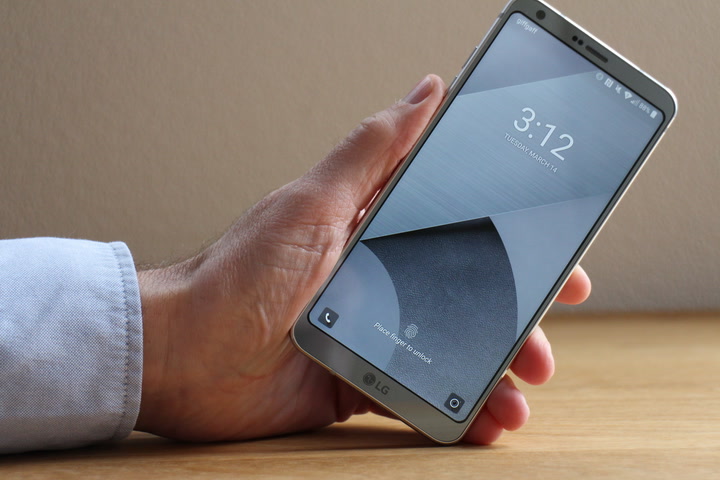














Comments